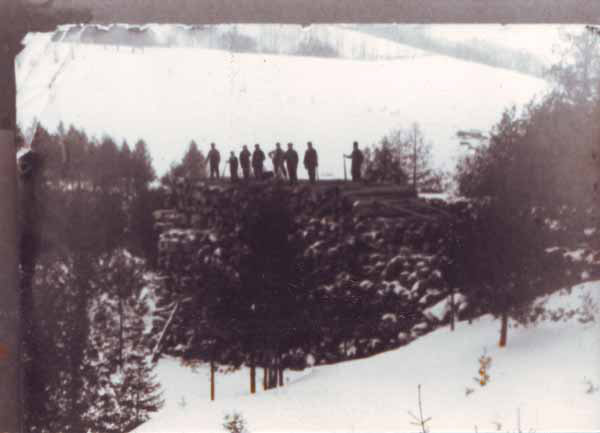The Glover Historical Society in the Northeast Kingdom of Vermont submitted this photo to us, asking if someone knew what this mysterious crib of logs was used for. Guesses in the office ranged from a trestle pier for a logging railroad to an art project that was undertaken for no reason other than the fact that it could be done.
What do you think?
Answer
We had wonderful responses to our Jenga riddle. More than a few people thought the logs were stacked this way so that the loggers could dry them prior to cutting them into lumber. (Though a sawyer would point out that since logs normally develop radial cracks when they dry, and because logs take a longer time to dry than boards, and because green logs are easier to saw than dry logs, this is probably not the correct answer.) There were several lookout-tower-type guesses – either a firetower or a Francophiles recreation of the Eiffel Tower or the base of the Statue of Liberty. (This later guess sounds a little fantastic, but the guesser submitted a newspaper clipping from 1882 that seemed to bolster his claim – check it out at http://query.nytimes.com/mem/archive-free/pdf?res=F70F16FF345A11738DDDAA0894D8415B8284F0D3)
Lots of guesses were practical in nature and suggested a tower from which to load logs onto a train, or a trestle foundation, or a bridge support, or a crib-dam (check out the picture at this link: http://www.exege.com/crib-dam). These guesses were balanced out by a fair share of whimsical guesses – an arboriculture pre-bucket truck, a silo, a big-ass deer stand, and Paul Bunyan’s winter wood pile spring immediately to mind.
Some insisted the picture was nothing more than a staged shot – loggers having fun for the sake of having fun and building something for the sake of building it. One went so far as to imagine dialogue:
Logger 1: How high do you think interlocking notched logs could be built?
Logger 2: Dunno. Let’s try it and find out.
Logger 1: Okay.
Later
Logger 2: That’s purty durn high.
Logger 1: Yep.
Others insisted that such hard-working men would never invest that much work into something just to say they’d done it. Oh, and then there were the bonfire guesses, either for the winter solstice, or the fourth of July, or the annual UVM – UNH basketball game.
Things were starting to spiral out of control when Caledonia/Essex County Forester Matt Langlais sent along the additional picture you see here. It’s from a postcard entitled Glover loggers, and perched on top seem to be the same eight loggers and the same dog. It seems reasonable to assume that this is the side view of the same log pile, which would indicate that the cribbing was nothing more than the end of the pile – the logs crisscrossed in this manner just like you’d block a free-standing wood pile.
Douglas Graham from Goshen, Vermont guessed just that, which makes him our lucky winner.
Thanks to the Glover Historical Society for sending along this picture – we told you our readers would help you out.

This week’s contest winner was Douglas Graham of Goshen, VT.


